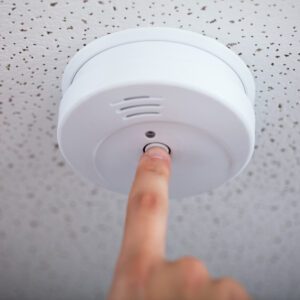
Smoke detectors, however, won’t do much good if they aren’t working properly. Do you know how to test your smoke alarm? It’s important to first understand the type of smoke alarm you have in your home, the different testing methods, and when to test your smoke alarm to ensure it’s working.
Types of Smoke Alarms
A house fire is one of the most devastating – and scary – events a homeowner can endure. The good news is with proper preventative measures and fire safety, most homeowners will never have to experience a fire. Fire safety begins with properly installed smoke alarms.
There are many affordable smoke alarm options on the market for residential use. A basic smoke detector can cost as little as $10, the cost of a few cups of coffee. This minimal investment can save lives and reduce the risk of large-scale structural damage to your home.
There are three types of smoke alarms on the market for home use – ionization, photoelectric, and dual sensor. All three types will alert you to a house fire, but each work in slightly different ways.
- Ionization: Ionization smoke detectors work when smoke interrupts air flow between two charged plates. These types of alarms tend to react quicker to smoke produced by flaming fires, such as a grease fire.
- Photoelectric: Photoelectric smoke alarms use light to help detect smoke. Light is aimed into a chamber at an angle from the sensor. When smoke hits the light, it reflects onto the sensor and the smoke alarm is triggered. This type of smoke alarm responds to slow-burning fires more quickly than ionization detectors.
- Dual Sensor: As the name implies, dual sensor smoke detectors combine the technology of ionization and photoelectric smoke detectors into one.
Because house fires are hard to predict, the US Fire Administration does not recommend one type over the other but rather recommends that every bedroom have both ionization and photoelectric smoke detectors, or a dual sensor.
Even with a solid fire prevention plan and working smoke detectors, fires can still occur. If you’ve suffered through a house fire and don’t know where to turn for help, the team at Reynolds Restoration Services provides fire and smoke remediation and home reconstruction services. While we hope you never need us, our emergency services team is on-call 24/7.
Testing Your Smoke Detector
Fire alarms and smoke alarms are only as good as the last time you tested them for effectiveness. No matter if your smoke detector is battery-powered or hard-wired, regular testing is recommended. In fact, it’s good to test your smoke alarm at least once a month and replace the batteries every year at daylight saving time.
There are two ways to test your smoke detector – basic testing and crisis testing.
- Basic Testing: Basic testing is when you use the manufacturer’s method of testing the smoke alarm. While the basic testing method may vary slightly between models, most instruction guides will direct you to press the “test” button on the device. Once the button is pressed, it will emit a loud, piercing sound after a few seconds. If you do not hear any noise, check the batteries to make sure they are working. Change the batteries and push the test button again. if the smoke alarm is still silent, it needs to be replaced.
- Crisis Testing: Crisis testing involves using an actual smoke material to test the device. It is not recommended to use actual fire for this form of testing – starting a fire in your home is not only dangerous, but the resulting smoke can also damage your smoke detector (smoke detectors should be replaced after an actual fire). Rather, use aerosol smoke. Aerosol smoke comes in a can and is sprayed from a distance at the smoke detector. After spraying the smoke, your smoke detector should go off in under 10 seconds. If the smoke alarm doesn’t trigger, replace the batteries and test again. Still no noise? It’s time to replace your smoke alarm.
LEARN ABOUT OUR FIRE AND SMOKE RESTORATION SERVICES
Fire and Smoke Damage Emergency Restoration Services
At Reynolds Restoration Services, we have worked with homeowners for more than 15 years who have experienced a structural loss due to a fire. We know the experience is grueling – between the emotional and financial loss, it can be a very stressful time. Our team of emergency fire damage restoration specialists has the training, patience, experience, and compassion to work with homeowners who have gone through a fire.
With offices in Harrisburg, Pa., Philadelphia, Pa., and Baltimore, Md., we can be on-site in a few hours to assist with fire damage restoration. If you’ve suffered a fire at your home or business, contact our 24-hour emergency response team at 888.277.8280. While we hope you never need to make the call, we are here to help with disaster restoration, water damage remediation, mold remediation, and more to restore your home to its pre-loss condition.

President of Reynolds Restoration Services. Over 20 years of experience in the emergency restoration industry.

